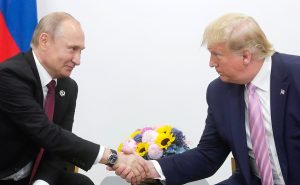Last month’s U.N. General Assembly 11th emergency special session – dedicated to the resolution of the war in Ukraine – illuminated a shift in support from the United States. The U.S. seems to have had a change of heart with the re-election of President Donald Trump and voted against Resolution ES-11/7, which proposed a lasting and just peace in favor of Ukraine. The resolution called for “the Russian Federation to… withdraw all of its military forces from the territory of Ukraine” and for the “immediate cessation of the attacks on the critical infrastructure of Ukraine.”
Previously, the United States championed and led the coalition against Russia, but now it is siding with its historical adversary. Most recently, Trump had a phone call with Russian President Vladimir Putin, which, in his words, was a “very good and productive” conversation. After that conversation an agreement was reached between these two world powers for Russia to cease strikes on Ukraine’s infrastructure and energy grids; the agreement, however, appeared to be immediately ignored by Putin as more than 40 Russian drones hit Ukrainian civilian infrastructure in Slovyansk.
Trump’s approach is starkly different from the previous U.S. administration under Joe Biden. Since the very beginning of the war in 2022, Biden was very clear on where his heart lies, proclaiming that Russia is “tearing at the very foundations of international peace and security.” His statement left no room for misinterpretation of his administration’s stance – a clear-as-day disapproval of Russia’s “violations.”
Besides statements, Biden met several times with Ukrainian President Volodymyr Zelenskyy during his term, including a bilateral meeting on the sidelines of the 2023 G7 summit in Hiroshima, Japan, and in September 2024 at the White House in Washington, D.C. The Biden administration was also adamant on supplying weaponry to Ukraine, as well as restricting U.S. investment into Russia-supporting states, such as China.
With the return of the Trump administration, however, support for Ukraine dwindled, as Trump pivoted to developing a mutually beneficial Russia-U.S. dialogue. Trump’s refusal to blame Russia for the conflict, the March 4 decision to discontinue the provision of intelligence and military aid to Ukraine, and recent remarks – such as his declaration that “it [Ukraine] may not survive” – all point to the Russia-supporting trajectory of the administration for the nearest future. Intelligence and military aid was reportedly resumed on March 12, but the damage to the relationship is clear.
These new developments have larger implications that go beyond the war in Ukraine. As put by former Prime Minister of France Dominique de Villepin, “America can no longer be considered an ally of Europe.” It has become one of three “illiberal superpowers,” along with Russia and China. Just exactly what does it mean for the U.S. – a historical torchbearer of democracy, liberalism, and liberty – to metamorphose into a freedom-denying illiberal state of unfathomable power?
It seems that the contemporary political scene’s resemblance to realpolitik is burgeoning with the return of the Trump administration. Hobbes’ “bellum omnium contra omnes” – or “the war of all against all” – is becoming a more and more relevant and accurate description of the current state of affairs as non-power-bearing states are forced to adjust to the (increasingly unpredictable) whims of superpowers such as the U.S. and Russia.
It is difficult to say what Central Asia’s response should be to this massive change of heart in Washington. Historically the U.S. has made efforts to strengthen its relations with Central Asia and distance the Central Asian states from Russia by creating the C5+1. This campaign was largely successful, with Central Asian states’ UNGA speeches becoming less and less Russia-aligned in recent years.
Now that the U.S. is siding with Russia, however, where does that leave Central Asia? The Trump administration appears interested in continuing the C5+1 framework. Its aggressive pursuit of rare earth minerals may be one of the factors that motivate it to maintain engagement with Central Asia. However, the administration’s disregard for democracy promotion could lead the region’s autocratic regimes to become even more repressive. As a result, their foreign policies may align more closely with the historic rivals of the U.S., such as Russia and China, both of which wield significant influence in the region.
In short, the future of Central Asia over the next few years remains highly uncertain. However, one thing is clear: this region has regained strategic importance with the change in U.S. leadership.

































